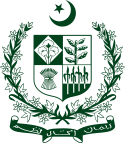Administrative units of Pakistan
 |
|---|
| This article is part of a series on the politics and government of Pakistan |
Pakistan is a country in Asia. It is divided into five provinces and two territories. Pakistan also administers part of Kashmir. This part is divided into two separate areas. The rest of Kashmir is administered by India.
Provinces and federal territories
[change | change source]List
[change | change source]Local government
[change | change source]Each province of Pakistan is divided into zillas - zillah is an Urdu word (ضلع) meaning district. There are 105 districts in Pakistan.
A district is divided into tehsils (تحصیل). A tehsils is similar to a county. Tehsils are used in all provinces except in Sindh province where the word taluka (Urdu: تعلقه) is used instead. Tehsils may contain villages or towns and cities.
Each tehsil is further divided into union councils. A union council is the smallest part of local government in Pakistan. They are sometimes made up of a few villages.
There are over 5,000 local government areas in Pakistan. Since 2001, these have been led by democratically elected local councils, each headed by a Nazim (the word means "supervisor" in Urdu, but is sometimes translated as mayor). Women have been allotted a minimum of 33% seats in these councils; there is no maximum limit to the number of women in these councils.
History
[change | change source]In the 1960s, Pakistan was simply divided into two "units" these were East Pakistan and West Pakistan. Shortly before East Pakistan became independent as Bangladesh, West Pakistan reverted to a system with four provinces. The provinces consisted of subunits called "divisions", which were further subdivided into districts, tehsils, and villages or municipalities.
In August 2000, Pervez Musharraf's local government reforms abolished the "division" as an administrative tier. A system of local government councils was established, with the first elections being held in 2001. Since then Pakistan has had greatly changed the local government system. The government had a plan to allow devolution. This plan according to the government "follows the principle of subsidiarity, whereby all functions that can be effectively performed at the local level are transferred to that level."
This means mean that decisions are made locally by people who live in the area and not in far away cities.
Other websites
[change | change source]- Government of Azad Kashmir
- Government of Balochistan Archived 2017-10-26 at the Wayback Machine
- Government of the Federally Administered Tribal Areas Archived 2009-07-20 at the Wayback Machine
- Government of the Islamabad Capital Territory Archived 2014-10-12 at the Wayback Machine
- Government of the Northern Areas Archived 2006-02-18 at the Wayback Machine
- Government of Khyber Pakhtunkhwa Archived 2003-08-03 at the Wayback Machine
- Government of the Punjab
- Government of Sindh Archived 2013-05-31 at the Wayback Machine
- Decentralization Support Program Archived 2011-09-28 at the Wayback Machine
- National Reconstruction Bureau Archived 2006-02-13 at the Wayback Machine
- ↑ Menon & Banerjea 2002, p. 5.
- ↑ Ring 1996, p. 288.
- ↑ "Dharamshala Declared Second Capital of Himachal | Hill Post". www.hillpost.in. 20 January 2017. Retrieved 2017-01-21.
- ↑ Kini 1974, pp. 34–35.
- ↑ Spate 1953, p. 200.
- ↑ Sati & Kumar 2004, pp. 9–10.
Cite error: There are <ref group=lower-alpha> tags or {{efn}} templates on this page, but the references will not show without a {{reflist|group=lower-alpha}} template or {{notelist}} template (see the help page).

